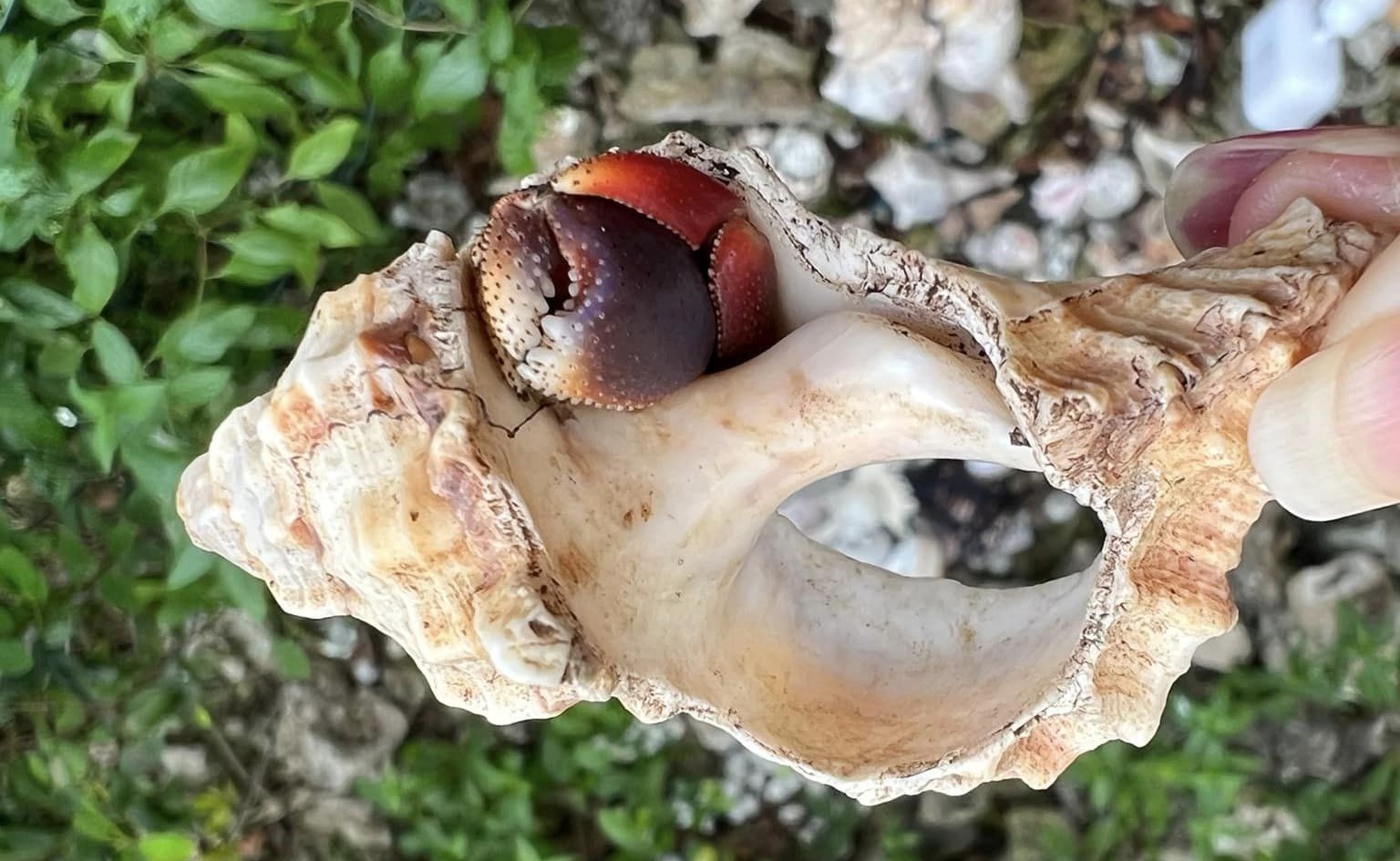Originally written by Vanessa Pike-Russell
Behaviour in the Wild

Land hermit crabs are territorial animals, and as such they will often act aggressively towards one another to establish a ‘pecking’ order among their colony. Sometimes this can be in the form of ‘feeler’ or antennae fights, others in violent pushing or flicking fellow tank mates out of the way. Usually this is not serious enough to warrant intervention. However, some hermit crabs will act in a manner that is harmful to other hermit crabs, often trying to pull their hermie buddy out of a desired shell, or attacking eyes, antennae, claws, legs or abdomen.
If you witness behavior that may be harmful to one or more hermit crabs, it is important to separate them until the aggressor has settled down. Sometimes tank aggression can be a precursor to a molt, or the result of being picked on or bullied in the past. The most common form of aggression is where one crab tries to pull their tank-mate out of the security of the seashell.
Handling with Respect and Gentleness

It shouldn’t be forgotten that hermit crabs are not toys, but living animals. It is important to pick them up gently, carefully and talking softly to them to let them know that they are safe is often a good idea. Use slow and gentle movements and always remember to carry them steadily. If you were placed on a palm and thought you were going to tumble off the edge, what would you do? A hermit crab doesn’t have hands with fingers, it has claws and legs. In order to save itself it will grip on with what it has available, so remember to help your buddy know he is safe from harm and put yourself in the place of the hermit crab at all times. A hermit crab treated with respect and gentleness will be gentle. A hermit crab that is handled roughly and with anger or haste will soon let you know that he can be just as crabby!
Autotomy

In the wild a hermit crab will “throw” a claw or leg if another hermit crab tries to pull them out of their shell. This is a responsive behaviour and their limbs are built in a way that they are able to “drop” or “throw” a limb easily so they may survive an attack. This is called Autotomy.
Normal Behaviour
Tumble Time

You may see your hermit crabs climb over the top of each other, or perhaps flick each other out of a prized spot or corner. This is natural behaviour, and doesn’t normally harm your hermit crabs. You may have watched puppies or kittens playing and vying for the best spot near Mummy dog, ‘rough-housing’ and play fighting. The flicking and tumbling another hermit crab out of the way is just in the nature of the territorial hermit crab and helps to establish ‘pecking order’ amongst hermit crabs.
Stridulation (Chirping or croaking)
Hermit Crab Chirping Croaking (click to play!)
I was doing some reading of my “Biology of the Land Crabs’ book today and came across a chapter on stridulation behaviour in land crabs. Of specific interest was a paragraph on Coenobita:
“Stridulation in conjunction with posturing is common in aggressive displays of Coenobita (Hazlett, 1966; S. Gilchrist, unpub). Clicking by rapping of appendages together and by tapping the shell are integral parts of aggressive encounters of C. clypeatus and C. compressus. When alarmed, Birgus latro briskly stamps the second peripods. At other times, even when not apparently alarmed, this crab produces continuous clicks (Grubb, 1971). This may be a proximity warning to con-specifics.”
[ Reference: page 130 from Biology of the Land Crabs. Edited by Warren W. Burggren and Brian R. McMahon. Published in 1998 by Cambridge University Press.]
I have other references which I will dig up (literally, its all in storage) and share. From personal experience my hermit crabs mainly chirp when there is another crab bullying them. Prime example was when I heard ‘rheet rheet rheet’ and went over to the tank, saw one crab over the top of another one and trying to pull the poor crab out of its shell! I’d be making a lot of noise too! Some crabs have chirped or croaked when being picked up, but very rarely. It reminds me of a car alarm – sometimes its a false alarm, other times it means something is wrong.
Antennae Fencing

Another thing that hermit crabs like to do is to go up to each other and have a hermie ‘antennae/feeler wiggling and touching’ encounter. You might see the antennae moving quickly, and brushing against the antennae of the other hermit crab. This may take a few minutes to die down, and either crab lose interest. Sometimes it is almost as if they are talking in code, giving signals to each other. As long as they are not hurting each other, it is often best to let them interact and develop their social skills with other land hermit crabs.
Cheliped Clashes
Sometimes they may even brush cheliped, grasping claw, against each other. IF this progresses into an entirely aggressive act, such as trying to sever antennae, limbs, eye stalks or removing the other hermit crab from its shell, THEN it is time to ‘break it up’.
Mating Behaviors
Often the mating ritual will appear aggressive at first glance. However, if you observe the crabs you will see the male guarding his chosen female and fending off other males. He will never attempt to pull the female from the shell but he may rock her gently to coax her to come forward from her shell so that mating can occur. If she is resistant he will simply follow her around until she changes her mind. Females enter their ‘mating season’ after a molt so you will often find the males clamoring for a freshly molted female.
Some guarding behavior in C. brevimanus:
More guarding behavior in C. Clypeatus:
Shell-based Aggression
When one crab likes another’s shell, say Crab A likes Crab B’s shell, Crab A will go up to Crab B’s shell, knock its shell ( that of Crab A) against the other crab’s shell (Crab B), causing the crab in the desired shell (Crab B) to come out and have a look at what is going on. Now the first crab will try to pull the second crab out of its shell by a cheliped or other limb. The second crab will normally drop his cheliped (grasping claw) or leg/s and retreat inside his shell, using his remaining cheliped to protect himself. Preferring to loose a limb instead of losing a shell.
Attempting to pull a hermit crab from its shell almost always results in the crab being torn in half (Ingle and Christiansen 2004), a testament to both its reliance upon its shelter and the strength to which its well adapted abdomen can hold on. The abdomen of all asymmetrical hermit crabs coils to the right and hence is better adapted to right-handed or dextril gastropod shells, though the less common left-handed shells are also utilised (Ruppert et al 2004). [1]
If there is a shell involved, it often helps if you place the attacker into a container with a number of suitable shells in different sizes, shapes and weights. It could well be that your hermit is crabby because his shell is too small. Imagine if you had to wear shoes two sizes small or large for you, and you were stuck in a glass tank and not able to go shopping to find a new one. What else could you do, but fight for the best shells with your tank mate. Remove the source of the aggression, and you will have relative peace and happiness in your crabarium.
Non violent shell theft video:
Deadly Behaviour
If you don’t remove the cause of the stress, you may just find that your overly stressed and crabby companion has ripped another hermit crab out of its shell, or viciously attacked it. If this happens, it is time to re-evaluate your crabitat and seashell collection, but first isolate the aggressive hermit crab and give it somewhere comfortable, equipped and containing an area it can retreat within darkness.
Somewhere Dark and Private

It is important that you have several spots within your tank for your hermit crabs to retreat within to escape the stress of life in captivity, mostly in partial darkness or protection from other hermit crabs. The most popular forms of tank decorations that meet this need are the Rock Caves, Coconut Huts, Hideout Dens, Terracotta (clean) flower pots, and more. Just like reptiles and many other animals, hermit crabs will be significantly less stressed if they believe they are protected from predators and allowed some cover of darkness.
Some Strategies
Over the past seven years I have had a handful of hermit crabs that were dangerously aggressive to their tank mates, and each time the best remedy was:

1. isolation
2. dark and private, quiet
3. access to more seashells, trade old shells for new shells, boil old shells and offer again
4. re-assess what you are feeding, is there enough protein in the diet?
5. observing the hermit crab on supervised visits to the crabarium
Larger Crabitats = More Space + Less Stress
If you are still having problems then it may help if you separate the crabs into two tanks, or up size to a larger tank if needed, with a barrier. Most of the time people use a 10 Gallon or 20 Gallon LONG tank, which has very limited surface area. Providing each hermit crab 5-10 gallons of free space each will reduce resource based aggression.
Photo Credits: Travis Wease, Vanessa Pike Russell, Stacy Griffith, Michelle Stephens, Melissa Nesgoda
References:
- Dardanus megistos by Storm Martin 2012







